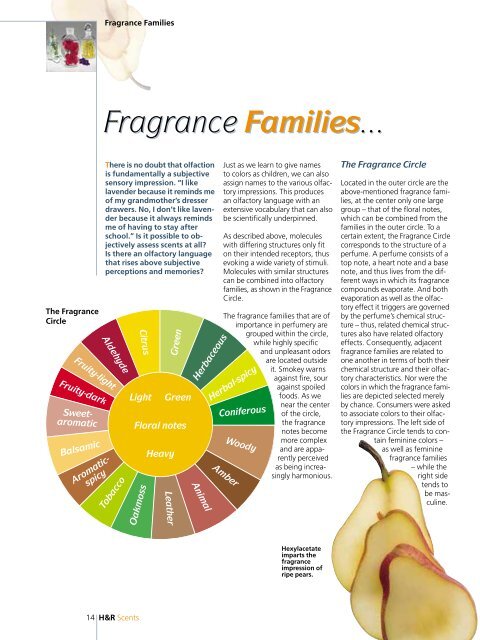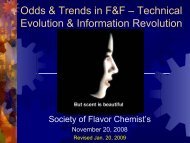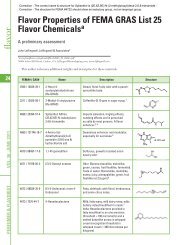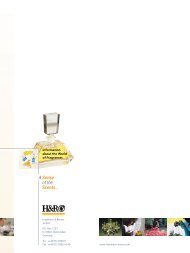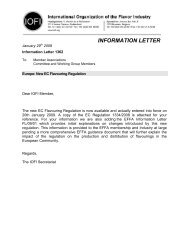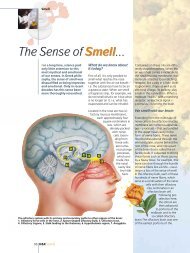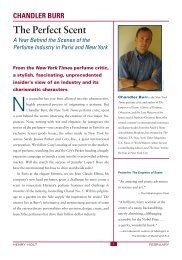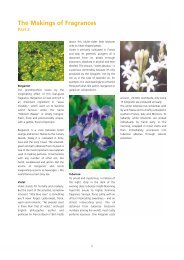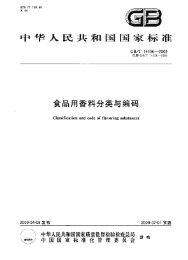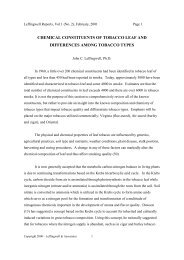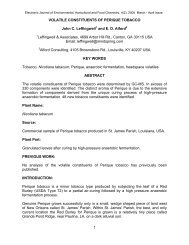Fragrance Families.pdf - Leffingwell & Associates
Fragrance Families.pdf - Leffingwell & Associates
Fragrance Families.pdf - Leffingwell & Associates
Create successful ePaper yourself
Turn your PDF publications into a flip-book with our unique Google optimized e-Paper software.
<strong>Fragrance</strong> <strong>Families</strong><br />
<strong>Fragrance</strong> <strong>Families</strong>...<br />
The <strong>Fragrance</strong><br />
Circle<br />
Fruity-dark<br />
Aromaticspicy<br />
Sweetaromatic<br />
Balsamic<br />
There is no doubt that olfaction<br />
is fundamentally a subjective<br />
sensory impression. “I like<br />
lavender because it reminds me<br />
of my grandmother’s dresser<br />
drawers. No, I don’t like lavender<br />
because it always reminds<br />
me of having to stay after<br />
school.” Is it possible to objectively<br />
assess scents at all?<br />
Is there an olfactory language<br />
that rises above subjective<br />
perceptions and memories?<br />
Aldehyde<br />
Fruity-light<br />
Tobacco<br />
Light<br />
Oakmoss<br />
Citrus<br />
Green<br />
Green<br />
Floral notes<br />
Heavy<br />
Animal<br />
Herbaceous<br />
Just as we learn to give names<br />
to colors as children, we can also<br />
assign names to the various olfactory<br />
impressions. This produces<br />
an olfactory language with an<br />
extensive vocabulary that can also<br />
be scientifically underpinned.<br />
As described above, molecules<br />
with differing structures only fit<br />
on their intended receptors, thus<br />
evoking a wide variety of stimuli.<br />
Molecules with similar structures<br />
can be combined into olfactory<br />
families, as shown in the <strong>Fragrance</strong><br />
Circle.<br />
The fragrance families that are of<br />
importance in perfumery are<br />
grouped within the circle,<br />
while highly specific<br />
and unpleasant odors<br />
are located outside<br />
it. Smokey warns<br />
against fire, sour<br />
against spoiled<br />
foods. As we<br />
near the center<br />
of the circle,<br />
the fragrance<br />
notes become<br />
more complex<br />
and are apparently<br />
perceived<br />
as being increasingly<br />
harmonious.<br />
Herbal-spicy<br />
Coniferous<br />
Amber<br />
Woody<br />
The <strong>Fragrance</strong> Circle<br />
Located in the outer circle are the<br />
above-mentioned fragrance families,<br />
at the center only one large<br />
group – that of the floral notes,<br />
which can be combined from the<br />
families in the outer circle. To a<br />
certain extent, the <strong>Fragrance</strong> Circle<br />
corresponds to the structure of a<br />
perfume. A perfume consists of a<br />
top note, a heart note and a base<br />
note, and thus lives from the different<br />
ways in which its fragrance<br />
compounds evaporate. And both<br />
evaporation as well as the olfactory<br />
effect it triggers are governed<br />
by the perfume’s chemical structure<br />
– thus, related chemical structures<br />
also have related olfactory<br />
effects. Consequently, adjacent<br />
fragrance families are related to<br />
one another in terms of both their<br />
chemical structure and their olfactory<br />
characteristics. Nor were the<br />
colors in which the fragrance families<br />
are depicted selected merely<br />
by chance. Consumers were asked<br />
to associate colors to their olfactory<br />
impressions. The left side of<br />
the <strong>Fragrance</strong> Circle tends to contain<br />
feminine colors –<br />
as well as feminine<br />
fragrance families<br />
– while the<br />
right side<br />
tends to<br />
be masculine.<br />
Leather<br />
Hexylacetate<br />
imparts the<br />
fragrance<br />
impression of<br />
ripe pears.<br />
14 H&R Scents
“Green” smells<br />
like freshly<br />
mown grass.<br />
So what are these families all<br />
about?<br />
■ Top note:<br />
Serves as the first impression of<br />
a fragrance, is intended to arouse<br />
curiosity and vanishes quickly.<br />
The families positioned in the upper<br />
third of the circle are employed in<br />
composing the top note.<br />
■ Heart note (bouquet):<br />
Forms the actual fragrance character<br />
of the perfume and lasts for hours.<br />
It usually consists of floral notes that<br />
can be accentuated with the adjacent<br />
families.<br />
■ Base note:<br />
Serves as the foundation upon<br />
which the perfume is based, is intended<br />
to pleasantly underscore the<br />
fading scent, and can last up to a<br />
day. It is composed from the fragrance<br />
families positioned in the<br />
lower third of the circle.<br />
Top notes<br />
Citrus<br />
Fresh, invigorating scents of<br />
citrus fruit, like lemon, orange,<br />
bergamot or grapefruit.<br />
Aldehyde<br />
Olfactory chain of the long-chain<br />
fatty aldehydes. This is a typical,<br />
fatty-sweaty, somewhat pungent<br />
and soapy olfactory note. The<br />
spectrum ranges from almondyfruity<br />
green nuances to ironed<br />
laundry fragrances and metallic<br />
nuances right through to ozone,<br />
ocean-like and waxy scents. Some<br />
of the aldehyde fragrances are<br />
related to the smell of human<br />
skin and perspiration.Aldehyde<br />
C10 offers citrus aspects, while<br />
Aldehyde C11 undecylene<br />
produces an animalic effect and<br />
Aldehyde C12 Lauric a cool,<br />
almost ozone-like note.<br />
Fruity-light<br />
Lively, light fruit fragrances,<br />
especially those from fruits with<br />
green and yellow peels. This group<br />
includes apple, pear, melon and<br />
pineapple scents, for example.<br />
As we have already seen, citrus<br />
fruits do not belong to this group.<br />
<strong>Fragrance</strong> examples include hexyl<br />
acetate, which has a pear-like<br />
scent, or melon bases.<br />
Green<br />
This group characterizes typical<br />
botanical fragrance notes, like<br />
those of leaves, stalks or freshly<br />
mown grass, as well as cucumbery-violet-like<br />
green. Vertocitral<br />
is reminiscent of leafy green,<br />
cis-hexenol of green grass, while<br />
nonadienol tends to be reminiscent<br />
of violet and cucumber.<br />
Herbaceaous<br />
<strong>Fragrance</strong> notes from the plant<br />
kingdom that are closely related<br />
to green. More complex than the<br />
actual green scents, herbaceous<br />
fragrances are more aromatic,<br />
generally with camphorous,<br />
minty, eucalyptus-like or earthy<br />
nuances. They are usually found<br />
on low-growing, unobtrusively<br />
blossoming plants, i.e. herbs.<br />
Typical examples include rosemary<br />
or sage, as well as peppermint<br />
and lavender, a fragrance that<br />
is both herbaceous and floral at<br />
once.<br />
Herbal-spicy<br />
The typical fragrance notes of<br />
such herbaceous kitchen herbs as<br />
thyme or mugwort. In addition to<br />
its herbaceous underlying scent,<br />
there is also a pronouncedly uniquespicy<br />
element, which produces an<br />
aromatic impression.<br />
Coniferous<br />
The fragrance note of whole or<br />
crushed conifer needles or resins,<br />
which can also display citrusy,<br />
herbaceous or aromatic-spicy<br />
elements, in addition to its typically<br />
earthy note. Moreover,<br />
these fragrances are more or less<br />
pronouncedly resinous and green.<br />
Pine needle oil is coniferous with<br />
citrus-like accents, while fir balsam<br />
tends to be aromatic-resinous<br />
with sweet aspects.<br />
“Citrus” –<br />
the fresh,<br />
invigorating<br />
scent of citrus<br />
fruits.
<strong>Fragrance</strong> <strong>Families</strong><br />
Heart (bouquet) notes<br />
Fruity-dark<br />
This group includes the sweet,<br />
sultry fragrance notes that mainly<br />
influence the heart and base<br />
notes of perfume compositions<br />
and have high substantivity.<br />
Examples include raspberry and<br />
peach.<br />
Floral notes<br />
Floral notes usually form the<br />
heart of a perfume. They, too,<br />
can be classified into light, green,<br />
floral and heavy. “Light” includes<br />
typical springtime flowers like<br />
lily of the valley (Muguet), lilac,<br />
freesia and light rose notes, often<br />
with citrusy or fruity elements.<br />
“Green” includes violet, for example,<br />
as well as other blossoms<br />
in which a leafy note dominates<br />
but can often have herbaceous,<br />
earthy nuances. Narcotic floral<br />
fragrances that are more often<br />
found in southern climates than<br />
in more northerly regions are<br />
considered “heavy.” These include,<br />
first and foremost, jasmin, tuberose,<br />
orange blossom and narcissus.<br />
In addition to the floral note,<br />
this group often contains pronouncedly<br />
balsamic, spicy and<br />
animalic notes. There are also<br />
hybrid notes, like hyacinth, that<br />
tend to be floral-heavy, but also<br />
have clear green notes, as well<br />
as violet, which is very green but<br />
can also be given a floral-woody<br />
interpretation.<br />
Base notes<br />
Woody<br />
This is a group of highly differing<br />
fragrances that are reminiscent<br />
of chipped wood. One of the<br />
differentiations that is made is<br />
cedar, which smells like a pencil<br />
with a camphorous off-note.<br />
Sandalwood tends to smell sultry,<br />
warm and somewhat animalic.<br />
Vetiver has a pronouncedly earthy<br />
root note. Patchouli also smells<br />
earthy, but also sweet with fruity<br />
nuances.<br />
Amber<br />
<strong>Fragrance</strong> notes that are similar<br />
to natural amber. This olfactory<br />
note is difficult to describe: Oilywoody<br />
with metallic elements,<br />
but also slightly nutty with a<br />
Sandalwood –<br />
a representative<br />
of the “Woody”<br />
fragrance<br />
category.<br />
Lilac is a floral note.<br />
nuance of seawater. The scent of<br />
amber is somewhat reminiscent<br />
of human hair. Natural amber<br />
consists of pathological secretions<br />
of the sperm whale. Since this<br />
whale population has unfortunately<br />
been decimated, true amber<br />
is a rarity today and very expensive.<br />
However there are imitations<br />
that come quite close to the natural<br />
note, such as amber Vitessence,<br />
as well as amber notes<br />
of botanical origin, such as labdanum.<br />
The Ambre 83 base has<br />
a very sweet amber note.<br />
Animal<br />
In addition to amber, there are<br />
three further notes of animal<br />
origin that are still employed in<br />
perfumery today – although they<br />
display the typical note of excrement,<br />
they offer an incomparable<br />
erogenous rounding-off effect in<br />
diluted form and in compositions.<br />
16 H&R Scents
Musk was originally obtained<br />
from the olfactory glands of the<br />
musk deer that is native to Asia.<br />
This tincture smells sweet and<br />
urine-like, as well as somewhat<br />
medicinal. Genuine musk tincture<br />
is priceless today and is very rarely<br />
used. When speaking of musk<br />
notes today, what is generally<br />
meant are aroma chemicals that<br />
are largely reminiscent of this<br />
note, although they typically have<br />
a more powdery and significantly<br />
less animalic scent. Civet absolue<br />
is obtained from the secretions of<br />
the olfactory glands of an African<br />
cat, the civet. As these animals are<br />
captured to obtain the secretions,<br />
without causing them any harm,<br />
civet is still in very widespread<br />
use today as an animalic note. Its<br />
scent is fecal-acidic with a slight<br />
honey note.<br />
Leather<br />
The fragrance notes of genuine<br />
leather and Russian leather. This<br />
term is interpreted very broadly.<br />
The typical components of leather<br />
compositions include birch tar<br />
oil, for example. Isobutyl chinoline<br />
often serves as an important<br />
leather element. The leather Vitessence<br />
offers a clearly leathery<br />
smell.<br />
Oakmoss<br />
This fragrance class refers to<br />
extraction products of specific<br />
lichen – especially those that grow<br />
on oak trees. The typical oakmoss<br />
note smells uniquely dry, algaelike,<br />
with a cheese-rind note and<br />
a tar-like, phenolic element, in<br />
addition to green nuances. Lichen<br />
that grow on other types of<br />
trees supply extraction products<br />
(tree moss) that smell woodier<br />
and more resinous.<br />
Tobacco<br />
<strong>Fragrance</strong> notes that are<br />
inspired by all tobaccolike<br />
notes, ranging from<br />
aromatically sauced<br />
pipe tobacco to cigar<br />
tobacco right<br />
through the smell<br />
of a stale ashtray.<br />
Tobacco absolue<br />
offers a typical<br />
scent.<br />
Aromatic-spicy<br />
Invigorating aromatic spice<br />
notes that can also contain<br />
bitter and/or piquant elements.<br />
Typical examples of<br />
these fragrances include<br />
cardamom, nutmeg,<br />
curry, clove and cinnamon.<br />
Balsamic<br />
Heavy, sweet, rich fragrances<br />
with chocolate-vanilla-like, cinnamon-like<br />
to resinous fragrance<br />
elements. These scents were already<br />
popular “Oriental” notes in<br />
ancient times, such as Peru balm<br />
or olibanum, i.e. frankincense.<br />
Nuances of this family can also<br />
be found in many orchid notes.<br />
The name is derived from the<br />
word “balsam,” which<br />
is used to denote<br />
certain kinds of resins.<br />
Sweet-aromatic<br />
Pronouncedly sweet<br />
fragrances that smell<br />
like honey, almond,<br />
marzipan, anise or<br />
woodruff, e.g. coumarin,<br />
often with richfruity<br />
or spicy nuances.<br />
In Spite of the segmentation<br />
in the <strong>Fragrance</strong><br />
Circle, it should be<br />
“Tobacco” in<br />
all of its facets<br />
is an interesting<br />
fragrance<br />
element.<br />
remembered that the first impression<br />
of a perfume is produced<br />
by the interplay between all of<br />
the fragrance materials that are<br />
employed in it – while leather, for<br />
example, is a base note, it is<br />
responsible producing the overall<br />
character of the perfume, and is<br />
not just present in the after-scent.<br />
Cinnamon<br />
is a typical<br />
representative<br />
of invigorating<br />
aromatic Spice<br />
notes.<br />
H&R Scents 17


